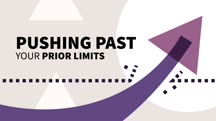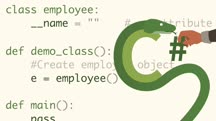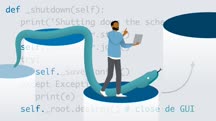Course catalog
Categories
Showing 1,121-1,140 of 1,450 items.
Project Management Foundations: Lessons Learned (216237)
One of the biggest problems with a fast-paced, goal-oriented world is that we often rush through projects and tasks, then move on to the next item on the list, rarely pausing to reflect on the results. What worked well? What were pain points? Inevitably, the same frustrating problems get repeated. How do you get out of this loop? In this course, Sam Yankelevitch introduces a better way forward through the discipline of lessons learned and shows how to collect lessons learned in projects and use those to improve current and future project outcomes. He covers topics like getting past typical objections, running lessons learned sessions, and tips and suggestions to support this critical part of project management. As Sam demonstrates, when you make lessons learned a strategic priority, you can achieve better results by getting previous and persistent obstacles out of the way and making better decisions.
Project Management Foundations: Quality (232115)
While quality may be a subjective measure when it comes to products like cars, clothes, or food, you can still loosely think of quality as a measure of expectations versus reality. When it comes to the realm of project management, defining quality is a little more cut and dry: To what degree did the project meet its requirements? In this course, Daniel Stanton provides project managers with an introduction to key quality management concepts. As Daniel points out, quality could be the main factor in making a sale and earning repeat business, and understanding the basics of quality management can help you deliver better results. He covers topics like metrics, Six Sigma techniques, quality function deployment, and Pareto analysis, and explains the difference between qualitative and quantitative quality metrics. After this course, you’ll have a better idea of the role quality management plays within project management.
Project Management Reinvented for Non-Project Managers (234597)
Over the past few years, organizations have seen a significant increase in the number of projects, asking employees and managers to spend more time on project-based work. Project management has become one of the most sought-after skills, yet most people have never learned the basics of project management. This course from project management expert Antonio Nieto-Rodriguez aims at providing an initial foundation, with easy to understand definitions and basic and refreshed project management concepts, to help you have a better understanding of your projects and what it takes to make projects succeed. If you’re one of the increasing number of people managing projects who don’t have a title that says “project manager,” this course is for you.
Project Management: Technical Projects (215251)
Technical projects have their own unique set of needs and challenges. The project manager and the business need to be aware and ready to respond to these challenges. Learn how to manage technical projects effectively with Bob McGannon. This course illustrates how to leverage project management tools differently and anticipate the technical component and business risks that are common to technology projects. Topics covered in the course include waterfall vs. agile, managing new and existing technologies, working with the expectation that technology solutions will be available 24/7, special considerations for technical product development, and much more. The course concludes with a set of problems and solutions that you can use to apply the principles from this course.
Note: This course was created by Bob McGannon. We are pleased to host this training in our library.
Note: This course was created by Bob McGannon. We are pleased to host this training in our library.
Project Management: Technical Projects (2016) (226879)
Technical projects have their own unique set of needs and challenges. New technology must be researched, downtime must be kept to a minimum, and the organization must be helped to adapt to the change. Learn how to effectively manage technical projects of any size with these tips from project management expert Bob McGannon. He'll go over specific approaches to mitigate the risks and challenges common to technology projects. He'll walk through case studies to bring the concepts to life. Then he'll propose some specific challenges (including conflicts with stakeholders or vendors) for you to explore. Compare your solutions with Bob's recommendations to see how your project management skills compare.
Project Resource Management (225332)
Resource management can make or break your project. Secure an insufficient amount of money, equipment, or, most importantly, staff, and your plans can quickly go awry. In this course, instructor Claudine Peet shares a step-by-step process for effectively managing resources throughout the project life cycle. Learn about the roles required for a project team, as well as how to set your team up for success by defining a resource management approach that's tailored to your project. Get tips for negotiating resource commitment, acquiring external resources, and establishing a team charter that helps all team members understand their responsibilities. Then, discover how to carry out a resource capability assessment and identify training and development opportunities that can address skill gaps. Claudine wraps up the course by explaining how to track your progress, deal with conflict, and disband the team when the project has ended.
Protecting Profitability by Reducing Financial Risk (141998)
Running a company is inherently a risky business. But with a cohesive risk management program, you can reduce financial liability, protect your property and your people, and make sure you stay open for business—no matter what happens. This course offers practical and implementation-ready solutions to protect organizational knowledge and valuation while reducing financial risk for businesses of all sizes and industries. It is designed for business owners, executives, and risk managers who want to protect digital, intellectual, and physical assets; keep employees safe; and guard against cyber threats as well as natural and man-made disasters. Business continuity expert Dan Weedin first reviews the risk management process, from identifying exposures to implementing and monitoring a risk management program. Then he shows how to protect your company by building a strong team that keeps organizational knowledge in-house and operational. Plus, learn how to plan for risks that are unique to the digital age, such as IP theft and cyberattacks, and buy insurance to mitigate financial loss in the worst-case scenario.
Protecting Your Network with Open Source Software (220640)
Network protection is vital to organizations big and small, but it doesn't have to be an expensive proposition. Learn how to protect your network with open-source tools, and do it completely free. Jungwoo Ryoo shows how to set up firewalls, investigate network traffic with a packet analyzer, detect threats and malicious activity with an intrusion-detection system, and enable network logging and monitoring. Start here for a low-cost route to a more secure network.
ProtoPie for UX Design (214418)
ProtoPie is a code-free prototyping tool that helps you build highly-interactive prototypes for mobile apps easily and quickly, so you can share your designs with clients and colleagues on any device. In this course, Ronnie McBride starts with the basics of ProtoPie, from installation to an overview of the prototyping interface to the core concept that drives the interactive methodology of ProtoPie. He then goes over interaction basics like importing assets, paging and scrolling, and creating triggers and responses. From there he takes a look at organizing layers, creating components, and defining variables and formulas. Ronnie finishes the course by demonstrating how to export and share your prototypes, including how to use the ProtoPie Player and ProtoPie Cloud, and how to record your prototype interactions to use them in a presentation.
Pushing Past Your Prior Limits (231095)
Whether or not we’re consciously aware of it, we are all walking around with a scorecard of other people’s expectations— the right place to go to college, the right person to marry, the right career to pursue. These expectations, definitions of success, and anxieties come from parents, teachers, friends, and so on. These scorecards keep us from being who we truly are. In this audio-only course adapted from the How to Be Awesome at Your Job podcast, Pete Mockaitis talks with Laura Gassner Otting about freeing yourself from other people’s expectations. As Laura explains in this conversation, when you’re unencumbered by the expectations of others, you can feel limitless and achieve a fulfillment in your life and your career that was previously obscured.
This course was created by Pete Mockaitis of How to Be Awesome at Your Job. We are pleased to offer this training in our library.

This course was created by Pete Mockaitis of How to Be Awesome at Your Job. We are pleased to offer this training in our library.

Python Data Structures: Sets and Frozen Sets (210865)
In this course, instructor Mridu Bhatnagar takes you through the basics of using Python sets and frozen sets. If you’re in the early stages of your Python programming career, or if you just need a refresher, join Mridu as she discusses the basic mechanics and functions of these data structures. Mridu gives a high-level overview of sets and frozen sets and then dives into the various methods to work with them. She discusses use cases and topics like how to modify a set and use built-in functions. Mridu also provides challenge and solution videos to test your knowledge as you go along. If you’re looking to learn important aspects about sets and frozen sets in Python, without jumping into a long project-based course, Mridu’s course is for you.
Python for Engineers and Scientists (218549)
This course offers scientists and engineers (ranging from students of those disciplines to experienced professionals) a dedicated, empowering introduction to Python for scientific and engineering applications. Theoretical astrophysicist and Python enthusiast Michele Vallisneri explains how Python can help you become a better engineer or physicist by making your work more efficient, accurate, and agile. Michele walks you through installing Python for macOS, Windows, and Linux, as well as setting up Jupyter notebooks. He explains how you can make Python fast using NumPy arrays, the SciPy library, Numba, and Cython. Michele then tackles ways to ensure your code is correct with tools for symbolic computation, differential equations, interpolation, and more. He finishes up with ideas to make your computational life easier with Python, including JSON, pandas, HDF5, automation with Python scripts, and scientific workflows with Snakemake.
Python for JavaScript Developers (209386)
Do you need to learn Python for your current job, for the job you want, or just for fun? In this course, instructor Ronnie Sheer shows you how you can leverage your existing knowledge of JavaScript to get started programming in Python. Ronnie compares Python and JavaScript, then covers how to set up and run a Python environment. He discusses how to write code that adheres to Python conventions, which can prevent bugs. Ronnie explains some of the basic logic in Python, including the use of indentation, how to write and debug control flow, how to use Python try/except appropriately, and more. He goes over objects and class definitions, then explores Python’s data model feature and mixins class. Ronnie goes into iteration in Python and shows how you can write more concise and elegant code in Python by using zip, enumerate, and list comprehensions. He concludes with a challenge that shows you how to apply your knowledge of JavaScript and Python to improve a small program.
Python for the C# Developer (221269)
Expanding your C# knowledge to include Python gives you a competitive advantage in the job marketplace. In this course, Joe Marini helps you translate your knowledge into the Python language. Python and C# share many similarities but are different in important ways. Joe explains the difference between C# and Python comment syntax. Python’s conditional statements and loop control statements are somewhat limited compared to C#. Joe walks you through the differences. Functions are a basic part of most programming languages. Joe shows you how several important functions work in Python. Python supports class definitions, single and multiple inheritance, abstract classes, and custom functionality. Joe compares and contrasts these with C# functionality. Joe shows you how to build and work with Python arrays of various data types, how to declare and use dictionaries in Python, and how to use iterators in Python. In conclusion, Joe discusses common operations like strings and exceptions.
Python Projects (218447)
Canned challenge problems are sufficient practice for brand-new Python developers. But if you're an intermediate programmer looking to bring a novel idea to life, you require more nuanced, in-depth instruction and practice. In this course, instructor Barron Stone helps you learn Python the hands-on way, showing you what it takes to bring a Python project to the finish line. He walks you step by step through his entire development process for a single personal Python project, from initial ideation to building the final installer for distribution. As you follow along, you can observe the thought process that Barron follows, giving you a path to follow to create your own projects.
Python vs. JavaScript for Development (214911)
Python and JavaScript are two of the most popular programming languages used by developers, analysts, and data scientists alike. But how do you know which language to use for specific projects or tasks? In this course, longtime instructor and software engineer Julie Nisbet answers this question and provides you with the tools you need to decide between these languages when approaching different projects. Julie starts by exploring the history of each language and how they operate. She then discusses key considerations when picking between each language for a project or task. Julie continues by reviewing key differences between the two programming languages, and closes by exploring various use cases for Python and JavaScript. Upon completing this course, you'll feel prepared to determine whether Python or JavaScript is best for you based on the project at hand.
This course was created by Madecraft. We are pleased to host this training in our library.

This course was created by Madecraft. We are pleased to host this training in our library.

Python vs. R for Data Science (218277)
Python and R are common programming languages used when working with data. Each language is powerful in its own way; however, it's important that you select the language that will best help you achieve your end result. In this course, data scientist and coding instructor Lavanya Vijayan helps you make this choice, sharing important considerations for using each language in various circumstances. Lavanya starts by going over the background of both languages, as well as the strengths and disadvantages of each in different scenarios. She then walks through the process of working on a data science project and how you'd handle the data at various stages using Python and R. Lavanya then covers how to analyze data using both languages. She rounds out the course by discussing the use cases that play to each language's strengths. By the end of this training, you’ll have the essential information you need to determine whether Python or R is right for you.
This course was created by Madecraft. We are pleased to host this training in our library.

This course was created by Madecraft. We are pleased to host this training in our library.

Python: Design Patterns (218107)
If you’re a programmer, you’re probably plenty busy, so why not save some time and avoid reinventing the wheel by reusing well-proven design solutions—software design patterns—to improve your code quality? Design patterns encourage programming efficiency and code reuse. In this course, Jungwoo Ryoo takes a look at traditional design patterns as applied to Python. Jungwoo Ryoo covers 15 essential creational, structural, and behavioral patterns to help you solve common coding challenges, while introducing best practices that can help keep your solutions consistent, complete, and correct.
Python: Design Patterns (2015) (226624)
Design patterns encourage programming efficiency and code reuse. This course is a look at traditional design patterns as applied to Python. Jungwoo Ryoo covers 15 essential creational, structural, and behavioral patterns to help you solve common coding challenges, while introducing best practices that will keep your solutions consistent, complete, and correct.
Python: Recursion (209301)
Recursion is part of the very fabric of computer science and software development, and whether you rarely use it or if it’s a key part of your development, there’s a good chance recursion is happening behind the scenes. Recursion is a powerful tool in breaking down complex problems into more manageable segments, and knowledge of recursion is a desirable trait that employers look for in developer positions. In this course, Robin Andrews takes a deep dive into the concepts, techniques, and applications of recursion using Python. He starts with some real-world examples of recursion, and then shows how it pertains to software development. He covers classic recursive algorithms like factorials and Fibonacci numbers, before showing how to write recursive algorithms in Python through practice exercises. After completing this course, you will have a better idea of how to use recursive algorithms to solve a wide range of software development issues.



















